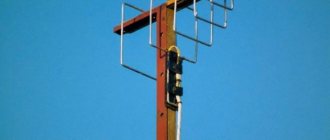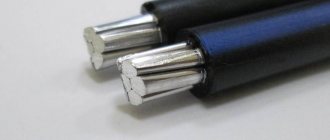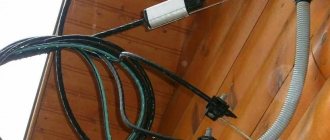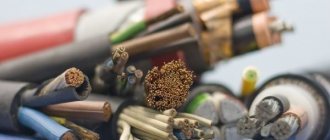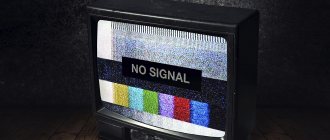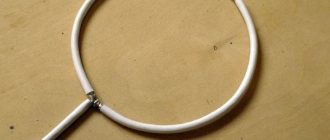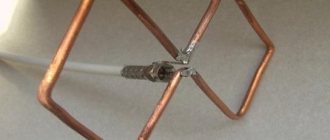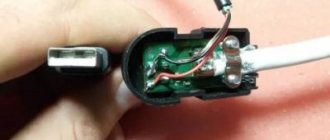The quality of digital television broadcasting directly depends on the cable used. Sometimes, due to a cable with a high level of signal attenuation, a person cannot watch his favorite TV shows normally. The stores offer dozens of models of cables of different cross-sections, dielectric quality, conductor composition and shielding layer. How to choose an antenna cable for digital television so that everything works like a charm? Let's discuss the best brands of television cables. If you are not interested in theory, but need to quickly select a cable, click here.
What should you pay attention to when choosing a digital cable?
Pay attention to the criteria that determine which cable is needed for digital television:
- Conductor cross section . The larger the conductor cross-section, the better the signal is transmitted over long distances. If the distance to the antenna is more than 30 meters (if it is located on the roof of an apartment building), then you should take a cable with a conductor cross-section of 1 mm2. For smaller distances, a cross-section from 0.5 to 0.9 mm2 is suitable.
- Conductor material . For digital television, you can use either a copper conductor or copper-plated steel.
- The amount of signal attenuation . The smaller this value, the higher quality the signal will be transmitted to the TV. The amount of signal attenuation is not always indicated in the product characteristics (or rather, very rarely), so it is worth checking with the seller. Note that the indicator is indicated in dB per 100 m.
- Signal amplification factor . This parameter depends on the quality of the screen made in a particular cable. The higher the indicator, the better the signal will be transmitted. On average, the gain for most brands is 60 - 80 dB, for more expensive and high-quality ones it is 90 dB.
- Wave resistance . The characteristic impedance of the coaxial television cable should be 75 ohms. Sometimes sellers recommend purchasing cables like RG-58A or RG-58C. However, they are not suitable for connecting digital television, since they have a characteristic impedance of 50 Ohms and are intended primarily for laying local computer networks.
Choosing a cable for your needs
Let's look at each popular television cable for digital television. Which one will be better for your needs is up to you to determine.
RG-6U
This is the optimal cable in terms of price/quality ratio. It has a steel conductor with a cross-section from 0.724 mm2 to 0.816 mm2 (depending on the manufacturer), coated with copper. The external insulation is made of PVC, and the internal dielectric is made of polyurethane with a thickness of up to 4.7 mm. The total cable diameter averages 6.6 - 6.8 mm.
Note that the RG-6U cable has good flexibility, so it is convenient for them to perform angular turns. It also has a relatively low signal attenuation rate of around 9.2 dB per 100 m of cable - this is better than its younger predecessor RG-59, although they are approximately the same price.
The only drawback is the low density of external PVC insulation, which deteriorates quite quickly under the influence of environmental factors. That is why it is better to use the cable for laying inside the house.
Average cost: 9 – 20 rubles per 1 m.
RK-75
This is the Russian analogue of the RG-6U cable. It has a huge number of varieties in terms of conductor cross-section, braiding and insulation. The core cross-section ranges from 0.75 mm2 to 1.63 mm2. To connect a TV to an antenna at a distance of up to 30 m, a cable with a cross-section of 0.75 - 0.9 mm2 is quite suitable. A thicker cable is only worth taking for satellite TV.
The outer insulation is made of polyvinyl chloride, and the braiding is made of tinned copper wire. Note that all types of RK-75 are able to withstand temperatures from -60°C to +60°C, and cope well with the influence of moisture and ultraviolet radiation, so it can be used for outdoor installation. The amount of bends should be at least 30 mm - this is enough to pass most corners.
Average cost: 13 – 30 rubles per 1 m.
SAT-50
The creation of the Italian company Cavel perfectly transmits high-frequency video and audio signals. The cross-section of the copper core of the conductor is 1 mm2, which allows the cable to be used for both digital and satellite television. The wire has a screen in the form of 64 aluminum threads with a cross-section of 0.12 mm2 and a double layer of foil. The screen perfectly blocks interference and improves signal transmission.
The signal improvement factor here is 60 dB, and the total wire thickness is 6.6 mm. The external insulation perfectly withstands UV rays and precipitation, so you can install the cable outside the window. The manufacturer claims that the cable has a service life of 15 years, but in fact it all depends on the operating conditions.
Average cost: 30 – 50 rubles per 1 m.
SAT-703
This is the older brother of the SAT-50 and is designed for laying over long distances (from 50 m). It has an increased copper core cross-section of 1.13 mm2 and a high-quality shielding system consisting of tinned copper wire and a double layer of foil. The signal amplification factor is 80 dB, which allows for virtually no loss of signal quality even with large sections of cable between the antenna and the receiver. They can connect several TVs to one antenna via a splitter.
Thanks to the foamed dielectric, the cable has low attenuation. It weighs 3.95 kg at 100 m - about 0.5 kg more than the SAT-50. The bends of SAT-703 must be at least 43 mm. For the most part, it is designed for installation in extreme conditions outside the window. It is not practical to install it indoors for reasons of economy.
Average cost: 35 – 60 rubles per 1m.
DG-113
The cable is manufactured by Cavel and is designed for connecting digital, cable and satellite television. It is considered the best in signal transmission, since the gain here is 90 dB thanks to the improved screen design made of tinned copper and double foil. The diameter of the copper core here is the same as that of the SAT-703 - 1.13 mm2. Note that the foamed dielectric is coated on top with a thin hydrocarbon layer (PIB), which improves moisture-proof properties. The outer insulation is resistant to ultraviolet radiation and does not crack over time.
The overall cable thickness is 6.6mm, so it fits standard 6mm F connectors. The manufacturer claims a product service life of at least 15 years. It is better to use the DG-113 cable, like the SAT-703, for outdoor installation, and use another cheaper one for indoor installation. Laying such a wire over long distances will cost a considerable amount, so if you want to save money, it is better to pay attention to cheaper analogues.
Average cost: 55 – 70 rubles per 1 m.
Tips for use
To avoid premature wire failure, adhere to the following recommendations:
- When choosing an antenna cable to your TV for residential connection, you should buy a model with high wave capacity.
- For outdoor installations in regions with extreme weather conditions (abnormal heat, excessive temperature fluctuations, increased precipitation, too low temperatures), choose wires with special impregnation.
- During the installation process, you should not make too many solders and connections, as this will negatively affect the quality of the signal. Laying a single wire is the optimal solution.
- You should not use home-made splitters; it is more advisable to acquire a proprietary device. In addition, splitters and signal amplifiers should be located in accessible places - it is possible that a breakdown will occur over time, and repairs will be carried out accordingly.
- During the installation process, follow the manufacturer's recommendations. This is especially true for the bending radius and the distance between fasteners.
- Under no circumstances should a coaxial cable be laid close to electrical appliances - this may cause interference.
The expert advice offered will help you make the right choice. As a result, you will achieve the highest possible quality of connection to television equipment.
Sources
- https://tehnika.expert/cifrovaya/televizor/vybor-televizionnogo-kabelya.html
- https://ProSmartTV.ru/tehnologii/koaksialnyj-televizionnyj-kabel.html
- https://prosmartv.ru/receiving/televizionnyj-antennyj-kabel-dlya-tv.html
- https://tvdigitally.ru/efirnoe-tsifrovoe-televidenie/kakoj-kabel-luchshe-sem-prakticheskih-sposobov-proverki-kachestva
- https://ProDigTV.ru/efirnoe/antenna/kabel-dlya-tsifrovogo-televideniya
- https://cifrovoetv-rf.ru/digital-television-cable-which-is-better/
- https://resiverplus.ru/kakoj-kabel-nuzhen-dlya-antenny
- https://vyborok.ru/qa/electronics/televizionnyj-kabel-kakoj-luchshe.html
- https://teleinside.ru/antennyj-kabel-dlya-televizora/
Coaxial cable design
Although coaxial cable may differ in conductor material and insulation quality, all types have approximately the same design:
- PVC insulation . It is resistant to ultraviolet radiation and protects the shielding layer and conductor from mechanical stress. May be black or white. Previously, black cable was intended for installation outside the window, and white cable inside the house. However, now manufacturers have moved away from such markings and now the insulation of almost every cable of any color can withstand environmental factors.
- Braided screen . The braid can be made of aluminum or copper wires. The thickness of each wire usually does not exceed 0.12 - 0.16 mm2.
- Foil screen . Along with the braiding, it protects the signal passing inside the wire from external interference. It can be single or double.
- Polyurethane dielectric.
- Conductor . The conductor can be made of pure copper or copper-plated steel. The first is more expensive and is usually used for satellite TV (although it is also suitable for others), while the second is cheaper and can be used for digital and terrestrial television broadcasting.
Marking
When you buy a domestic product, there are usually no difficulties with its designation.
- RK - radio frequency cable;
- 75 - conductor resistance 75 Ohm;
- 4.8 - diameter;
- 34 - the first digit shows the insulation group, heat resistance category. The second digit is the serial number of the development;
- TU - technical manufacturing conditions.
But the labeling of imported cables can be confusing. Meanwhile, here is the definition of Western standards:
- DELINK - manufacturer;
- SAT-752 - name;
- Cu/Cu - material of the central conductor and braid (Cuprum - copper);
- 1.13 - thickness of the central core;
- 0.12*64 - thickness and density of the braid;
- Cu-foil - full copper;
- Coaxial cable - coaxial cable;
- 75 OHM - conductor resistance 75 Ohm;
- ISO 9001-2000 - certificate of conformity.
Results: which cable for digital television should I buy?
- For installation exclusively indoors (if the antenna is on the balcony), RG-6U or RK-75 is suitable. They can also freely connect the antenna to two or more TVs.
- For installation inside and outside at a distance of no more than 20 m to the antenna, you can take RK-75.
- If in the future you plan to change digital to satellite TV, then immediately mount SAT-50 - it has a copper core, and when the cable is raised up to 30 m, it will be enough for your eyes.
- If the distance from the TV to the antenna is about 50 - 100 m and you do not want loss of signal quality, then it is better to take SAT-703 or DG-113.
